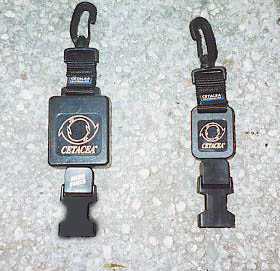
Securing Devices
from

| When I first started kayak fishing, I noticed that sometimes I
would return with less equipment than I started out with. Whether it was a set of pliers, a
sheath, a bait knife or even a fishing rod once, I knew something had to be done to prevent
further loss. As I got more involved with the sport, the amount of gear and accessories I
brought out with me increased. VHF handheld radios, game clips, and multiple fishing rods
were just some of the gear I began to accrue for kayak fishing.
Kayak fishing can sometimes be like a juggling act, holding a paddle in one hand while you're fighting a fish in the other. All this action may be going on while there is a 6 foot swell rolling under you combined with a 15 knot wind. Regardless if the conditions are calm or rough, there isn't much deck space on a kayak to work with. If your $250 marine radio falls out of your hand, it's most likely going to end up in the water regardless of the marine conditions. I looked to the world of SCUBA diving for the solution. SCUBA divers are always using fancy quick release coil lanyards and retractors for securing various items of equipment yet still be able to access and make use of them at any time. |
 |
Built to handle pressure and saltwater, these are perfect for securing certain items on a kayak or to your person while kayak fishing. Cetacea retractors include a high impact molded case, flush holes for easy draining and cleaning, resistance against marine rot and abrasion, and non-corrosive stainless steel springs. I use the larger retractor for landing sizeable game fish. The retractor is secured to a tank well strap and connected to a game clip. Some game clips already come with a male connector (male and female connector accessories are available). |
| With a 3ft nylon chord and an 80lb breaking strength, it's a perfect
way to secure a good size game fish or stringing up smaller ones (not to be used for landing
sharks).
I use the smaller retractor for securing my VHF handheld marine radio to my person. I connect a male clip to my radio and secure the retractor to my PFD or paddle pants. I can use the radio at all times without worrying about losing it overboard or getting tangled up in a "slacked" leash. The radio can also be quickly detached from the retractor when needed. There are dozens of companies manufacturing retractors. Most of which are meant more to be used as "janitor key rings" rather than securing items in a marine environment. Don't trust retractors built for general land use! |
|
| Leashes are sometimes used by kayak anglers to secure their paddles and fishing rods. When ever possible, I try to stow my rods inside the hatch of my kayak. On the days I don't feel the surf or other conditions will be a threat to my fishing rods, I put them in the rod holders and connect the quick release coil lanyards. The brass clips can be connected to any eyelet or wrapped around a tank well strap. The shorter end with the female clip is connected to the rod (I connect mine to the rod butt near the reel base). I usually unclip the main leash when I'm fishing though the rod is still fishable while connected. The lanyard is a plastic chord surrounded by waterproof nylon material. Since the clips are brass and plastic, these leashes are impervious to saltwater. | |
| (click for larger view) | |
| We all have various ways of accessorizing and outfitting our kayaks
for fishing. For me, the name of the game is to keep it simple without sacrificing some of
the equipment you might take out fishing with you if you were on a boat. With all that equipment
in such a limited area, fastening devices are an absolute necessity in preserving our gear. Cetacea offers a number of quality securing products and accessories to accommodate the needs of
kayak anglers.
You can visit Cetacea online at www.cetaceacorp.com.
Reviewed December 12, 2002 by Jason Morton
<back |